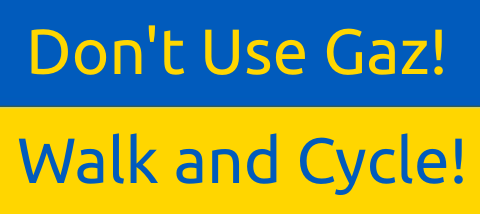
If you want your local councillor to learn more about this, or to ask them to send local council officers to learn more, you can ask them to go to Cyclenation's conference on Fri 23rd November. You can use the website 'WriteToThem' to contact them. If you want to learn more about this, come to the Cyclenation campaigner's conference on Sat 24th November. (Concessionary tickets available for both events - contact us for details)
The West Midlands, along with other urban areas of the UK, is facing major problems from the dominance of private cars. Air pollution and a lack of physical activity are impacting children's development and leading to poor health affecting quality of life and hundreds of thousands of premature deaths. Congestion is costing the UK economy billions of pounds every year, and local economies are suffering due to out-of-town shopping. In September, Transport for West Midlands (TfWM) released a new Congestion Management Plan with 10 key points to cut congestion. But it has a significant omission that is going limit its effectiveness and leave the West Midlands with ever increasing congestion. With a projected extra 444,000 people living here by 2035, meaning an extra 1.2 million trips per day and a 34% increase in private car use, it is impossible for the road network in the West Midlands to cope with the increase in demand without significant changes in travel patterns.
It is important to note that 41% of car journeys in the West Midlands are within 2 miles, and 67% are under 5 miles. Where short car journeys touch main roads, they contribute to congestion. Each junction that a short car journey crosses has reduced capacity for cars being used for longer journeys, even if the short car journey is not going anywhere near the centre of Birmingham or any of the other cores in the West Midlands. By reducing the number of short car journeys, space can be freed up for buses and motor traffic making longer journeys, easing congestion. So there is the potential to move many of those journeys to walking and especially cycling, but the measures in the Congestion Management Plan are not going to achieve that on their own.
The Congestion Management Plan does talk about the best mode of transport to replace these journeys - cycling - with talk of a new bike share scheme across the West Midlands and the development of a Infrastructure Delivery Plan for cycling which will enable TfWM to apply for funding to build more cycle tracks and other infrastructure. And the plan includes measures to encourage travel behaviour change through travel planning and marketing. It helpful tells us that one way we can help is to leave our car at home because "... for shorter trips walking or cycling could be the fastest route to your destination..." But will a new cycle hire scheme, more travel education and extra cycle tracks work?
The evidence suggests that cycling and walking need to be given an advantage over driving before many people will make the switch. In places such as the centre of London, where congestion makes driving a car much slower, cycling had been increasing even before the cycle hire bikes and superhighways were installed, but on in places such as the edge of London, where congestion hasn't yet made it undeniably faster to cycle, rates are still low. Research into the effect of London's 'Mini-Hollands' one year into their implementation by Rachel Aldred at the University of Westminster has found an increase of roughly 40 minutes extra physical activity each week for residents in those areas. This was not only extra time spent cycling, but also spent walking. A key feature of several of the Mini-Holland schemes has been the cutting out of rat-running motor traffic, forcing drivers to stick to the main roads. This has given walking and cycling the advantage over driving that they needed in order to grow.
The London Cycling Campaign and Living Streets launched a set of documents earlier this year about 'Low Traffic Neighbourhoods', focusing on how to learn from the Mini-Holland successes and implement similar schemes elsewhere. The key point is that small cells of streets (about 1km2 for each cell) should be clustered around local centres and transport nodes. Within each cell, through motor traffic is completely prevented, so cars are forced onto the distributor roads between the cells. By giving walking and cycling an advantage over driving, people can be nudged into changing transport modes, leading to the noticeable changes in physical activity just 1 year after a scheme has been introduced. This is the key missing element in TfWM's Congestion Management Plan: making it more difficult to drive short distances to make walking and cycling more attractive. Segregated cycle tracks along main roads are very important, but without the political will to make short car journeys more difficult, the potential gains from improved cycle infrastructure on main roads will not be fully realised.
The key objection that is likely to be made by councillors and council officers to the plans is that easy access to drive across the city is necessary to ease congestion on the main roads and to provide a safety valve when crashes on main roads block them up. But this ignores the reality that congestion on the main roads has already pushed motor traffic into the side roads and that there is no capacity to cope with the traffic when a main road is blocked. For example there are numerous side roads around Bristol Road to by-pass blockages, but when Bristol Road is blocked, the side roads seize up and don't move either. By blocking rat-runs and reducing the short car journeys that are clogging up junctions on roads like Bristol Road, congestion can start to be reduced and local areas will become much more pleasant to live in.
It is very important that Low Traffic Neighbourhoods are delivered in partnership with local communities. TfWM and the local councils need to identify local centres that they want to focus on, and then work with local communities to develop plans that meet their needs. Nobody wants to have a rat-run down their street, so these schemes need to be sold as improvements for locals to give back their roads to them. The cost of implementing these schemes can be as cheap as a few bollards, and when done properly, they can transform neighbourhoods completely.


